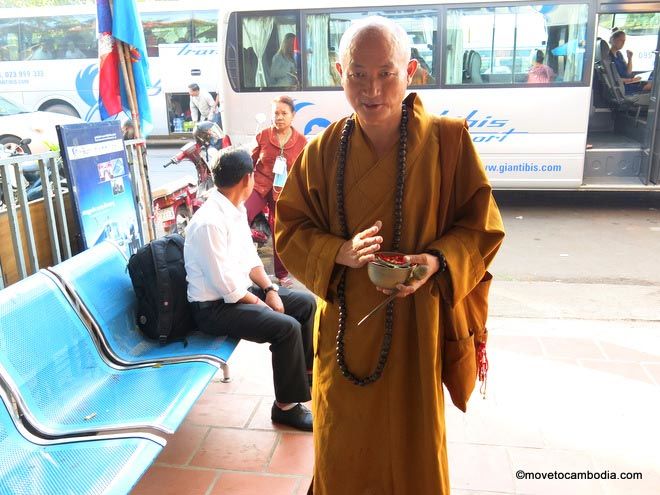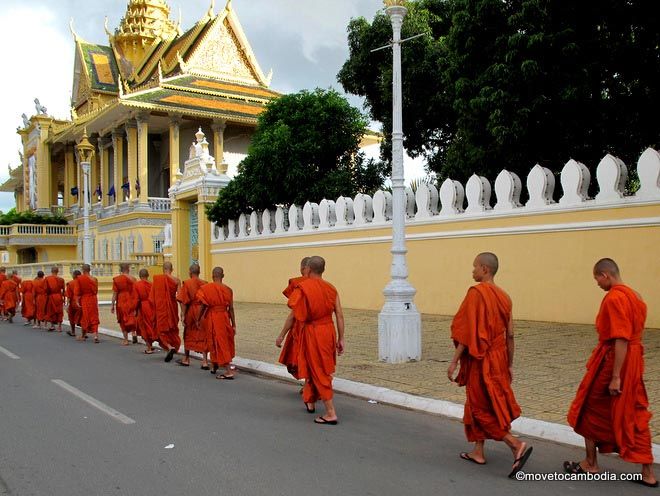Been stopped by a monk asking for a donation? They’ve been spotted all over the world, so it’s no surprise that Cambodia hasn’t escaped those greedy pests, fake monks. Although you’ll find them from Melbourne to San Francisco, fake monks are especially insidious in Cambodia, a Buddhist country and home to thousands of real monks.

This is not a real monk. Do not give him money.
Tourists here delight in seeing monks, and a photo of a saffron-clad monk at the temples is a coveted holiday treasure. Because tourists are so keen to see real monks, it’s no wonder that the fake-monk scam has taken off in Cambodia. You’ll find faux monks anywhere in the country where there are tourists — Sihanoukville, Phnom Penh, and Siem Reap — and their goal is to rip off tourists.
How to spot a fake monk in Cambodia: Fake monks are usually Chinese and are often (but not always) dressed in brown or mustard-colored robes, unlike the bright orange garb of their authentic Khmer counterpart, and will wear pants underneath their robes. They are usually middle-aged, while most Cambodian monks are in their twenties or even younger. Fake monks don’t usually speak any Khmer and very little English, other than to demand more money. They often wear wooden prayer beads and offer people bracelets or amulets. Fake monks will often collect money well into the night, unlike real monks who only collect in the morning. Perhaps most importantly, it’s reported that they don’t seem to know anything about Buddhism.
What’s the scam? Fake monks ask for cash donations and are rarely satisfied with what they are offered. They sometimes have bracelets that they’ll tie around your wrist, or amulets that they will give you and then demand cash for. Tourists are told that monks in Cambodia must be treated with respect, and most responsible tourists try to do just that. So when a monk demands a donation, it can be very hard to say no. It’s being reported that the fake monks are asking for donations not just from tourists but from Cambodians, who, as Buddhists, have an even harder time saying no to a monk.

The real deal: Cambodian monks in Phnom Penh.
One of the precepts for Cambodian monks states that they must not handle money. Traditionally in Cambodia, Buddhists donate food or medicine as the monks go on their morning alms rounds. This tradition is eroding, though, as Cambodia becomes a more cash-centric society, and it’s common to see people giving a few hundred or a few thousand riel to visiting monks. However, taking cash is still a violation of the precepts for Cambodian monks, and you will never see a “real” monk begging or asking for money.
In a New York Times article about fake monks in Manhattan, Robert Buswell, director of the Center for Buddhist Studies at UCLA, said, “Aggressive begging is utterly unheard-of in the Buddhist tradition. The monks typically do not even acknowledge the offering.” In Cambodia, real monks stand quietly outside homes or businesses, holding their begging bowls, waiting to be noticed. They do not beg.
Say no to fake monks. While this scam isn’t the most harmful one around — it does nothing worse than relieve tourists of a little of their money — it puts real monks, and Cambodian Buddhism generally, in a bad light. Cambodian monks have enough of their own real-life dramas and scandals to contend with; they don’t need a bunch of fake Chinese monks sullying their reputation even further. Giving money to a faux monk and later finding out that you’ve been scammed is an unpleasant experience for a tourist, and people who give money to fake monks are less likely to give to real organizations that will actually help Cambodians. The experience would be even worse for a Cambodian, whose donation may represent a much bigger sacrifice. So say no to fake monks, and spread the word.
Wondering what fake monks look like? Artist John Weeks captured this video and has more great photos on his blog.
Have you been scammed by a fake monk? Tell us about your experience in the comments section.
Monks in Cambodia take money for alms, not food. If you look around, locals actually give cash, and some receive a blessing from the monk afterwards. Monks have a sorta fixed route within the community which they embark on in the morning and locals who want to contribute will call out to the monks and place the cash in the monk’s urn. I once peeked inside while making a donation. Did not see any food but tons of small Riel notes
Wonderful impish friend of ours, here in New Orleans, got so sick of these guys he made small signs, with sticky tape on the back. Whenever a phony monk approaches him, he leans forward, pats him on the back with a huge smile, and attaches the sign, which says, I AM A FAKE MONK. DON’T GIVE ME MONEY.
chinese fake monks also appear in ueno park in Tokyo.
please be careful. Japanese real monks do not approach from them ask for money!
for the detail pls check the link below of Asahi news paper of Japan.
http://www.asahi.com/ajw/articles/AJ201704120042.html
I’ve been in Phnom Penh on and off for the last two years and it seems to be getting worse. Just recently I saw the same ‘monk’ three times in the same night. Started politely saying no “awt Jung om” don’t need uncle, then aw tey “no”. Finally resorting to English No quite loudly, he then muttered something neither in English or Khmer and walked off, I was eating at a local Cambodian street stall so was surprised he approached. About 1 hour later he returned through stubbornness or sheer stupidity as it was clear I was getting a little angry. Said “no, no, no” and he left.
2 hours later at a different spot, a bar along the riverside he approached me again, luckily I was having a conversation with the staff and a tuk tuk driver at the time who quickly ushered him away.
It infuriates me that these people are trying to scam money from tourists who think they are actually doing a good deed. If any monk approaches, especially, at night, you can be pretty sure he is not a real one. Please wait until the morning (usually very early) when they do their call to alms and just follow what the locals do, that way the money will be used for what you intended.
Wish I had read this earlier, I was scammed today while walking along the waterfront in PP. Monk approached me and offered me a wooden beaded bracelet, not knowing any better I accepted but did ask how much as I knew it couldn’t be free, I ended up parting with a $1 which I had to out in bowl that he produced from his shoulder bag. its such a shame this happens.
In PP today (15 Nov 2015) walking along Street 13 between Streets 172 and 178. Stopped to take in surroundings (a tuk tuk driver asked us if we needed his services – we said no) and approached by a smiling monk holding out a metal tin with some $s inside. He also held out red bracelets – we said no as someone had told us (in India) that true holy men would never ask for money. He still stood there smiling and holding out the tin and then the tuk tuk driver essentially gave him his marching orders by shouting the equivalent of ‘get lost’ at him. He walked off shouting back at the tuk tuk driver over his shoulder (very un-monk-like behaviour!). As this column points out, he was middle aged, wearing brown robes with trousers underneath which we could see as he walked off. As noted above real monks will wait to be noticed outside a business and never proactively ask or beg. NB: In India (Pushkar) it’s the other way around. The older guys are the real monks, the younger ones are fakes on the make!
I was in Siem Reap with my four year-old daughter. We’ve been approached by several fake monks, mostly at the streets leading to the night market. Their approach is to hand bracelets to my daughter who thinks she is receiving a present, then refuse to take them back and push me for money with a monologue that is not understandable besides a rising number of dollars requested. I fell for this the fist time but then saw through it – one even walked straight into our hotel lobby and then continued to yell at us all the way out on the street after I made my daughter refuse to accept the amulet.
For them to try to involve a small child is especially outrageous. Such bad behavior!
Sad commentary. Sorry for your daughters experience. The most infamous “monk” stays at the Green Day Angkor Guest House on Wat Bo Street. I wish the guest houses would refuse their money as they know they are scams.
Cambodian “real” monks don’t approach tourists for money. In the morning monks will offer locals the opportunity to support them via small donations of money or food placed into their alms bowl. In return the local will be told a prayer and receive good karma for supporting a monk.
They are relatively easy to spot. As you say, they wear street clothing under their “wrap ” and are very agressive. Real Monks are not agressive. I will admit I did get taken the first time, got a hug, a bracelt and a shoulder massage so gave him $2 and then got a demand for $10. Gave back the bracelet and said “No Way!”